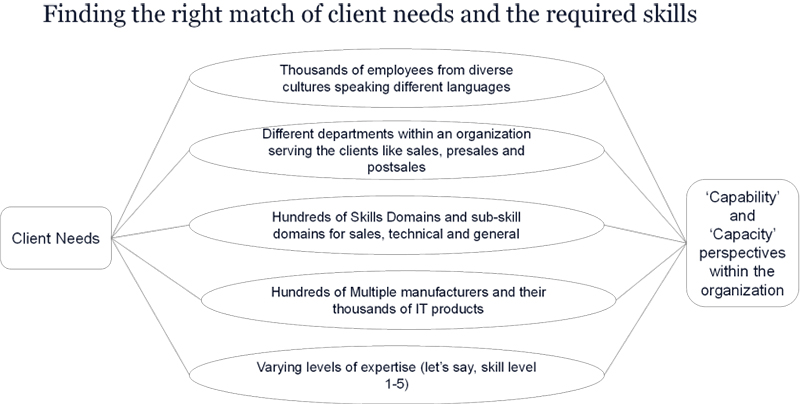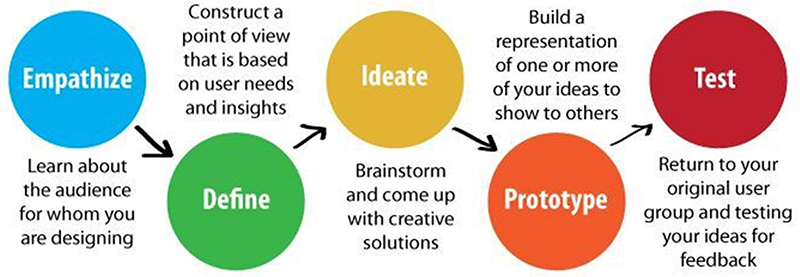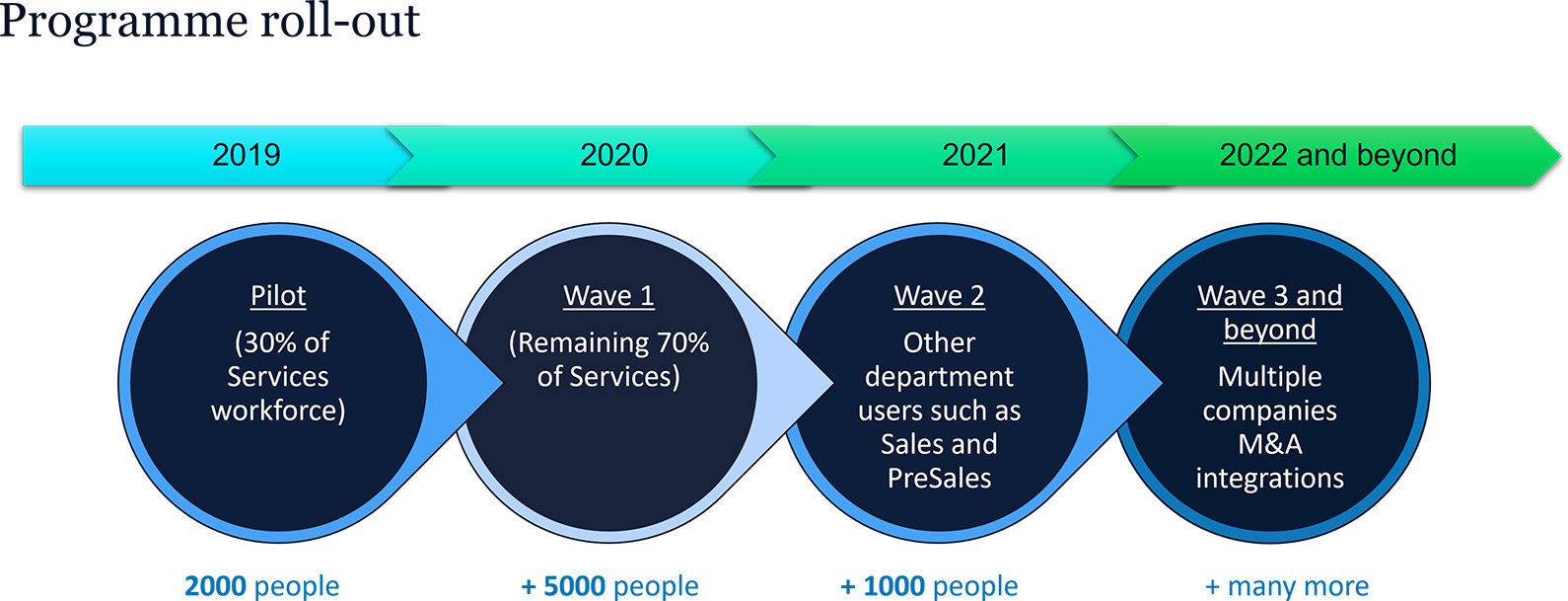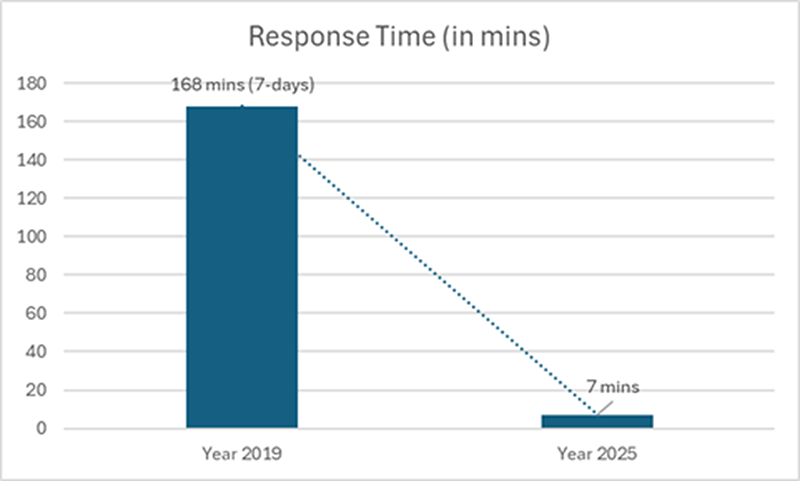
Mastering Skills Visibility: A Smarter Way to Align Talent with Demand
How to locate the right skills for client requirements in less than 7-mins esp. within a global organization?
As the organization grows beyond the local geographical boundaries of a city, state or even nation, aligning the right skills and capabilities for providing consistent services to clients becomes a challenge. This blog post discusses similar problems that a global innovator organization faced while expanding its reach in global territories in the last decade and how it overcame the issues of keeping capabilities of its people consistent while also making the information easily available to business stakeholders whenever and wherever it is required. This helped to provide better services to clients.
We'll delve a bit deeper into the below important aspects of managing this as a programme:
- Index
-
- Reimagining Workforce Capability: A Strategic Approach to Skills Visibility at Scale
- The Challenge: Complexity Without Consistency
- Our Approach: Design Thinking in Action
- Scaling the Solution: Continual Improvements through Agile Rollout Across Borders
- The Impact: Faster Responses, Smarter Decisions, Stronger Partnerships
- Conclusion
1. Reimagining Workforce Capability: A Strategic Approach to Skills Visibility at Scale
In today's ever-evolving business environment, the ability of an organization to deliver consistent, high-quality services hinges largely on one core factor: people. From solution development to project delivery, the collective capabilities of employees are instrumental in driving exceptional client experiences. But as emerging technologies such as Artificial Intelligence (AI) and Generative AI reshape client expectations, companies must evolve in parallel- ensuring that their workforce has not only the right skills but also the readiness to apply them at speed.

While upskilling and professional certification are essential for adapting to this change, an often overlooked challenge is maintaining a centralized, dynamic, and accessible repository of these capabilities. For global organizations with operations spanning multiple countries, inconsistency in how employee skills are captured and reported can create significant inefficiencies. When client requirements span diverse geographies and involve complex multi-product solutions, the lack of a standardized skill visibility framework can delay response times and hinder delivery assurance.
The picture below depicts this complexity of mapping client requirements to internal capability and available capacity:

As we can see in the above picture, skills of employees is a complex metrics and there are lot of hidden aspects of the skills. For example, communication language proficiency of an employee is very critical to know especially for cross-border engagement with clients. Therefore, an employee with no English language proficiency can't be engaged for an international assignment (onsite or remote) despite having relevant sales, presales or technical skills.
2. The Challenge: Complexity Without Consistency
Consider a typical scenario: a client in Southeast Asia requires rapid deployment of a technology solution across ten countries. To respond effectively, service architects must validate delivery readiness across multiple regions-each with varied systems, team structures, and reporting formats. What should take hours often takes days, as information is manually gathered from different teams, often via spreadsheets, emails, and informal channels. The time lost in locating the right expertise not only delays service but can impact client confidence and project success.
This challenge isn't limited to client-facing situations. Internally, talent development teams struggle to identify candidates for upskilling programs that align with strategic goals or partner commitments. The situation becomes even more complex during mergers or acquisitions, where workforce data must be harmonized to support unified service delivery across legacy organizations.
3. Our Approach: Design Thinking in Action
Addressing such a multifaceted challenge required a fresh perspective. We turned to Design Thinking-a proven methodology that emphasizes empathy, collaboration, and iterative problem-solving for our global client.

Source of this image: blogspot.com by MIT's Steve Eppinger on Design Thinking. Also refer: A Brief History of Design Thinking: It's origin and evolution
Through this process, we engaged both internal stakeholders (such as project managers, sales teams, and delivery leads) and external clients to understand how skill visibility gaps were impacting their day-to-day work. We:
- Empathized with users across 2-3 countries to uncover pain points in locating and validating capabilities.
- Defined the problem with real-world scenarios and feedback loops.
- Ideated possible solutions that could be quickly piloted.
- Prototyped a lightweight, scalable solution using Excel-based templates and Power BI dashboards.
- Tested the prototype with regional teams, refining it until it was ready for broader deployment as a Minimum Viable Product (MVP).
In just three months, we built a foundational system with clear use cases and adoption pathways, ensuring the solution was grounded in the realities of a globally distributed workforce.
As security of this kind of critical information is a key compliance requirement, the solution was designed from the very start keeping the security of database in mind. Another important consideration was to ensure the access of the overall system as well as specific individual records is restricted to only nominated persons-in-charge and follows an approval process with timely reviews of access control and security.
Below picture explains the evolution of solution over last 6 years:

4. Scaling the Solution: Continual Improvements through Agile Rollout Across Borders
Transformation doesn't end with a prototype. To achieve meaningful scale, we adopted a programmatic, agile approach to rollout-building momentum across multiple internal waves and business units. This allowed us to:
- Incorporate real-time feedback to enhance the platform's usability
- Launch global Skills Transformation Programmes aligned to strategic growth areas
- Introduce features like cross-border skills matching, resource forecasting, and workforce readiness views for client proposals
- Ensure change adoption with minimal disruption across different teams and cultures
Each wave brought new capabilities and more users into the ecosystem-turning what began as a skills inventory into a strategic business enabler.
The picture below gives a high-level overview of the entire Programme rollout in different waves where each wave of the rollout covered a progressive set of mass users to increase adoption and make it an organization-wide initiative.

As we can imagine, any organization-wide programme rollout like this requires strong change management fundamentals especially around managing stakeholders and communication throughout the rollout of the programme. Some of the key actions that proved pivotal to the success of the programme were timely leadership buy-in and monthly cadence with wider teams across geographies to increase adoption of the new system.
We continuously improved the platform to include adoption of newer features like automation to further improvise the response time to users and ensuring regular updates to skills repository by employees to keep the information up-to-date and relevant to evolving market needs.
5. The Impact: Faster Responses, Smarter Decisions, Stronger Partnerships
The results speak for themselves. Where it once took a week to coordinate a skills-based response to a client inquiry, it now takes just minutes. Teams across continents can quickly access relevant capability data, plan project readiness, and respond to market demands without delay.

Another important outcome was some hidden aspects of the skills e.g. communication language of the team members, is easy to locate now because of a database that includes all the complex metrics of skills information captured e.g. language of communication, skill domain, sub-skill-domains, manufacturers, products and specific skill ratings for each product/solution/service.
A very useful outcome with the help of newer technologies like AI / Generative AI is that any type of insights can be now available at the click of a mouse and regular updates keep the information relevant for market demands.
Business partners have taken notice too. To share a testimony of central skills repository and its use-case in later years, nearly 8,000 employees were upskilled through these transformation initiatives for one of our largest global business partners in just 12 months, while for another global business partner over 1,000 employees have completed the training and certifications for new technologies in under four months. These outcomes have dramatically improved our time-to-market for new offerings and created stronger alignment with client needs.
Internally, the workforce now benefits from clearer career paths, targeted development plans, and greater collaboration through shared visibility. It is much easier to locate and engage cross border expertise for putting our best foot forward, thus ensuring better services to our esteemed clients. Externally, the clients trust the organization's ability to scale quickly, execute reliably, and deliver results-regardless of geography.
6. Conclusion
For any organization navigating a complex, fast-moving global market, skills visibility is not just an HR initiative-it's a strategic differentiator. Our journey shows that with the right mindset, methods, and momentum, it's possible to create a sustainable, scalable capability framework that fuels both innovation and execution.
As technologies continue to evolve, so will the need to anticipate, assess, and align workforce capabilities accordingly. And those who succeed in doing so-proactively and programmatically-will be best positioned to lead in the future of work.

Mahesh Sikri
Director of Service Transformation
NTT Data Inc. - Asia Pacific Region
Responsible for Skills Transformation Initiatives (esp. focused on strategic partners' enablement, partner specializations and capability metrics management), Technical Communities of Practice, Automation Practice (including AI/GenAI) and Deal Assurance for large sales pursuits across 13 countries in APAC Region
Related links
